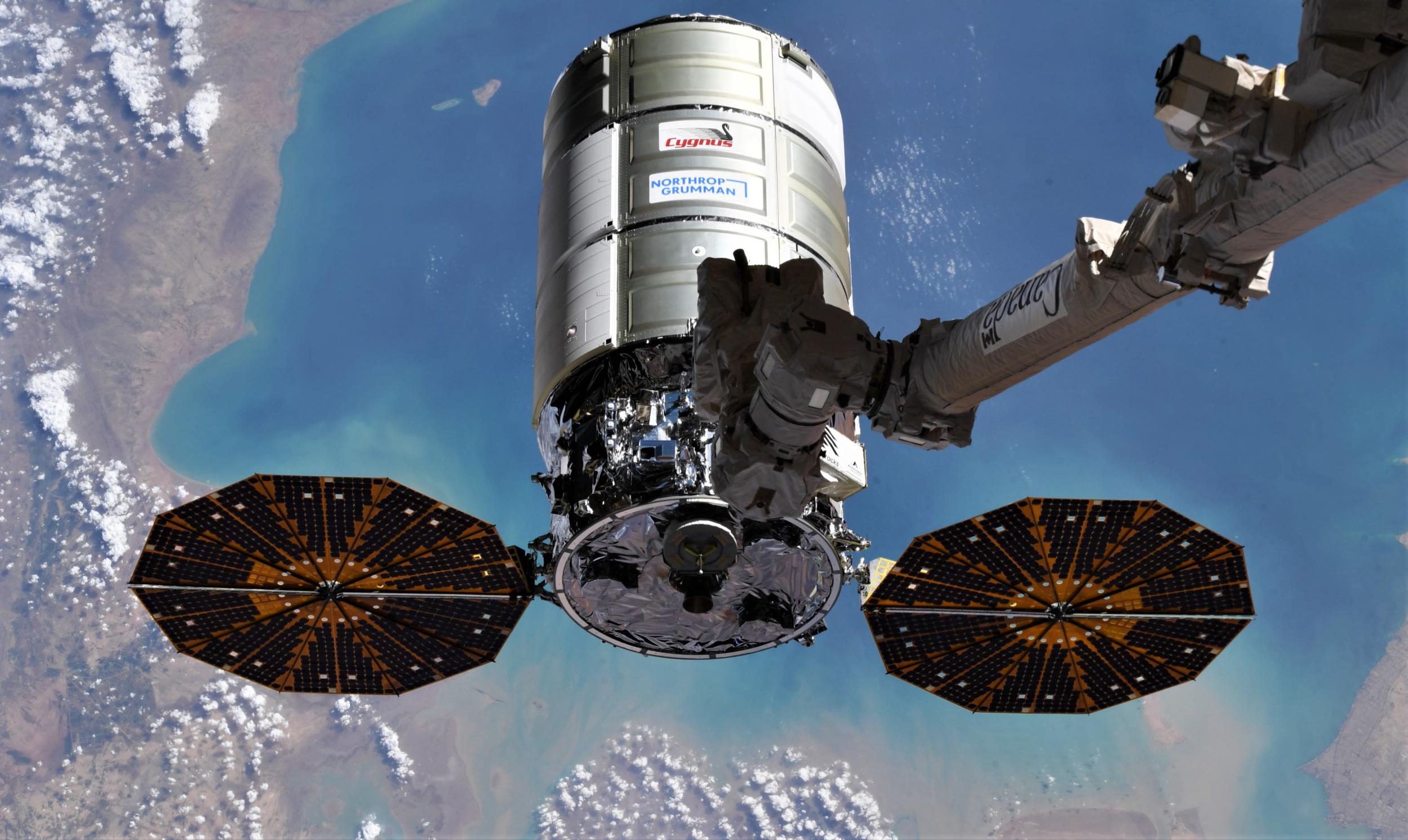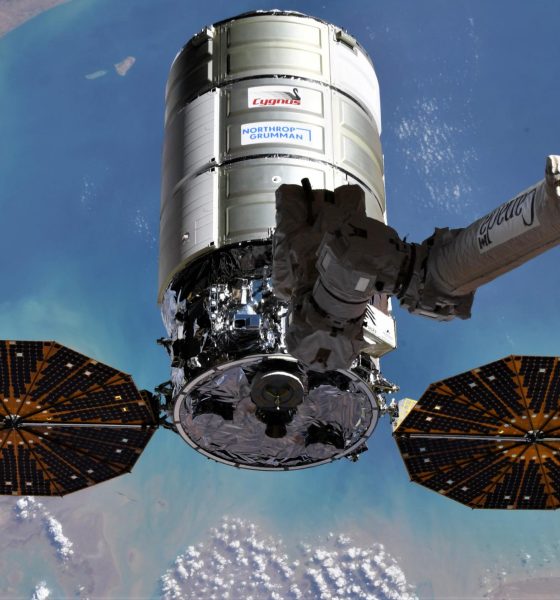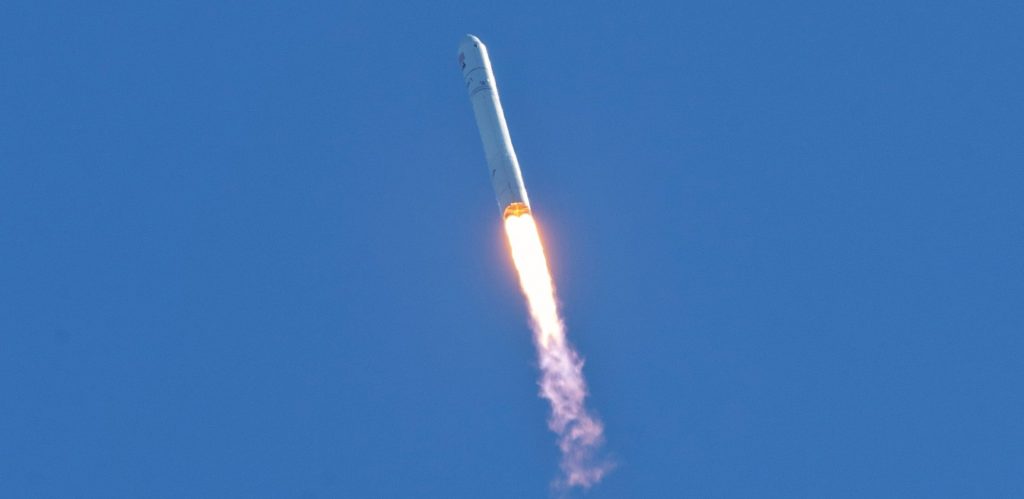

News
Antares rocket launches Cygnus spacecraft to the International Space Station
Northrup Grumman has launched a fresh batch of supplies and equipment to the International Space Station with its Antares rocket and Cygnus spacecraft.
On Saturday, February 19th, an uncrewed Northrup Grumman Cygnus spacecraft lifted off on an Antares rocket from Pad 0A at NASA’s Wallops Flight Facility in northeast Virginia. As part of Northrup Grumman’s 17th Cargo Resupply Services (CRS) mission to the International Space Station since 2013, the rocket successfully carried the Cygnus spacecraft and more than 3.7 tons (~8300 lb) of cargo into orbit.
At 4:44 AM EST Monday, February 21st, Cygnus finished its autonomous rendezvous with the ISS and the station’s robotic Canadarm2 arm – operated by NASA astronaut Raja Chari – grabbed the hovering spacecraft and ultimately installed it on a berthing port later that morning. Prior to its arrival, NASA astronauts Raja Chari and Kayla Barron trained on the US Destiny laboratory module’s robotics workstation to prepare for the capture operation.

The update that's rolling out to the fleet makes full use of the front and rear steering travel to minimize turning circle. In this case a reduction of 1.6 feet just over the air— Wes (@wmorrill3) April 16, 2024
On February 22nd, ISS astronauts began the process of unpacking Cygnus, which brought with it an array of supplies, snacks, scientific investigations, and critical materials needed to support over 250 experiments aboard the ISS. That list of experiments includes medical research, technology development, space safety work, and plant life investigations. In one investigation, cancer cells from breast and prostate cancer will be treated with MicroQuin, a novel cancer treatment drug. This investigation will allow tumors to be treated in a microgravity environment, allowing researchers an opportunity to better understand and characterize their structure, gene expression, cell signaling, and response to the treatment.
The NG-17 mission also carried a modification kit that will pave the way for the installation of the new set of upgraded solar arrays. The second batch will be launched no earlier than (NET) May 2022 on SpaceX’s CRS-25 Cargo Dragon 2 spacecraft. Additionally, NASA says that Cygnus NG-17 “[included] other components [needed] for the successful functioning of astronaut life on the space station, such as a trash deployer and acoustic covers for the waste management system.” (NASA)
In general, NG-17 was loaded with:
• 2,980 pounds (1,352 kilograms) of crew supplies
• 2,883 pounds (1,308 kilograms) of [station] hardware
• 1,975 pounds (896 kilograms) of science investigations
• 200 pounds (100 kilograms) of unpressurized cargo
• 132 pounds (60 kilograms) of spacewalk equipment
• 77 pounds (35 kilograms) of computer resources
While attached to the ISS, Cygnus will also be responsible for raising the altitude of the space station for the first time in its history. This will be the first time since the Space Shuttle’s retirement in 2011 that an American spacecraft helps maintain the space station’s orbit – a task Russia has exclusively handled for more than a decade. “This Cygnus vehicle has been modified to [use some of its own propellant] to reboot ISS. We’ve done a test prior to this with Cygnus, but this will be our first real use of this capability to actually re-boost the station. And it gives us another way to do so, in addition to the Russian Zvezda thrusters or the Russian Progress cargo spacecraft capabilities,” stated Dina Contella, NASA’s ISS operations integration manager.
Cygnus will remain attached to the International Space Station for the next three months and is set to depart in May. Once detached from the ISS, the spacecraft – operating a bit like a space tug or orbital transfer vehicle – will deploy a number of cubesats. Finally, the fully expendable spacecraft will dispose several thousand pounds of trash when it reenters and burns up in Earth’s atmosphere later this year.

News
Tesla China delivery centers look packed as 2025 comes to a close
Needless to say, it appears that Tesla China seems intent on ending 2025 on a strong note.

Tesla’s delivery centers in China seem to be absolutely packed as the final days of 2025 wind down, with photos on social media showing delivery locations being filled wall-to-wall with vehicles waiting for their new owners.
Needless to say, it appears that Tesla China seems intent on ending 2025 on a strong note.
Full delivery center hints at year-end demand surge
A recent image from a Chinese delivery center posted by industry watcher @Tslachan on X revealed rows upon rows of freshly prepared Model Y and Model 3 units, some of which were adorned with red bows and teddy bears. Some customers also seem to be looking over their vehicles with Tesla delivery staff.
The images hint at a strong year-end push to clear inventory and deliver as many vehicles as possible. Interestingly enough, several Model Y L vehicles could be seen in the photos, hinting at the demand for the extended wheelbase-six seat variant of the best-selling all-electric crossover.
Strong demand in China
Consumer demand for the Model Y and Model 3 in China seems to be quite notable. This could be inferred from the estimated delivery dates for the Model 3 and Model Y, which have been extended to February 2026 for several variants. Apart from this, the Model Y and Model 3 also continue to rank well in China’s premium EV segment.
From January to November alone, the Model Y took China’s number one spot in the RMB 200,000-RMB 300,000 segment for electric vehicles, selling 359,463 units. The Model 3 sedan took third place, selling 172,392. This is quite impressive considering that both the Model Y and Model 3 are still priced at a premium compared to some of their rivals, such as the Xiaomi SU7 and YU7.
With delivery centers in December being quite busy, it does seem like Tesla China will end the year on a strong note once more.
News
Tesla Giga Berlin draws “red line” over IG Metall union’s 35-hour week demands
Factory manager André Thierig has drawn a “red line” against reducing Giga Berlin’s workweek to 35 hours, while highlighting that Tesla has actually increased its workers’ salaries more substantially than other carmakers in the country.

Tesla Giga Berlin has found itself in a new labor dispute in Germany, where union IG Metall is pushing for adoption of a collective agreement to boost wages and implement changes, such as a 35-hour workweek.
In a comment, Giga Berlin manager André Thierig drew a “red line” against reducing Giga Berlin’s workweek to 35 hours, while highlighting that Tesla has actually increased its workers’ salaries more substantially than other carmakers in the country.
Tesla factory manager’s “red line”
Tesla Germany is expected to hold a works council election in 2026, which André Thierig considers very important. As per the Giga Berlin plant manager, Giga Berlin’s plant expansion plans might be put on hold if the election favors the union. He also spoke against some of the changes that IG Metall is seeking to implement in the factory, like a 35-hour week, as noted in an rbb24 report.
“The discussion about a 35-hour week is a red line for me. We will not cross it,” Theirig said.
“(The election) will determine whether we can continue our successful path in the future in an independent, flexible, and unbureaucratic manner. Personally, I cannot imagine that the decision-makers in the USA will continue to push ahead with the factory expansion if the election results favor IG Metall.”
Giga Berlin’s wage increase
IG Metall district manager Jan Otto told the German news agency DPA that without a collective agreement, Tesla’s wages remain significantly below levels at other German car factories. He noted the company excuses this by referencing its lowest pay grade, but added: “The two lowest pay grades are not even used in car factories.”
In response, Tesla noted that it has raised the wages of Gigafactory Berlin’s workers more than their German competitors. Thierig noted that with a collective agreement, Giga Berlin’s workers would have seen a 2% wage increase this year. But thanks to Tesla not being unionized, Gigafactory Berlin workers were able to receive a 4% increase, as noted in a CarUp report.
“There was a wage increase of 2% this year in the current collective agreement. Because we are in a different economic situation than the industry as a whole, we were able to double the wages – by 4%. Since production started, this corresponds to a wage increase of more than 25% in less than four years,” Thierig stated.
News
Tesla is seeing a lot of momentum from young Koreans in their 20s-30s: report
From January to November, young buyers purchased over 21,000 Teslas, putting it far ahead of fellow imported rivals like BMW and Mercedes-Benz.

Tesla has captured the hearts of South Korea’s 20s-30s demographic, emerging as the group’s top-selling imported car brand in 2025. From January to November, young buyers purchased over 21,000 Teslas, putting it far ahead of fellow imported rivals like BMW and Mercedes-Benz.
Industry experts cited by The Economist attributed this “Tesla frenzy” to fandom culture, where buyers prioritize the brand over traditional car attributes, similar to snapping up the latest iPhone.
Model Y dominates among young buyers
Data from the Korea Imported Automobile Association showed that Tesla sold 21,757 vehicles to the 20s-30s demographic through November, compared to BMW’s 13,666 and Mercedes-Benz’s 6,983. The Model Y led the list overwhelmingly, with variants like the standard and Long Range models topping purchases for both young men and women.
Young men bought around 16,000 Teslas, mostly Model Y (over 15,000 units), followed by Model 3. Young women followed a similar pattern, favoring Model Y (3,888 units) and Model 3 (1,083 units). The Cybertruck saw minimal sales in this group.
The Model Y’s appeal lies in its family-friendly SUV design, 400-500 km range, quick acceleration, and spacious cargo, which is ideal for commuting and leisure. The Model 3, on the other hand, serves as an accessible entry point with lower pricing, which is valuable considering the country’s EV subsidies.
The Tesla boom
Experts described Tesla’s popularity as “fandom culture,” where young buyers embrace the brand despite criticisms from skeptics. Professor Lee Ho-geun called Tesla a “typical early adopter brand,” comparing purchases to iPhones.
Professor Kim Pil-soo noted that young people view Tesla more as a gadget than a car, and they are likely drawn by marketing, subsidies, and perceived value. They also tend to overlook news of numerous recalls, which are mostly over-the-air software updates, and controversies tied to the company.
Tesla’s position as Korea’s top import for 2025 seems secured. As noted by the publication, Tesla’s December sales figures have not been reported yet, but market analysts have suggested that Tesla has all but secured the top spot among the country’s imported cars this year.








